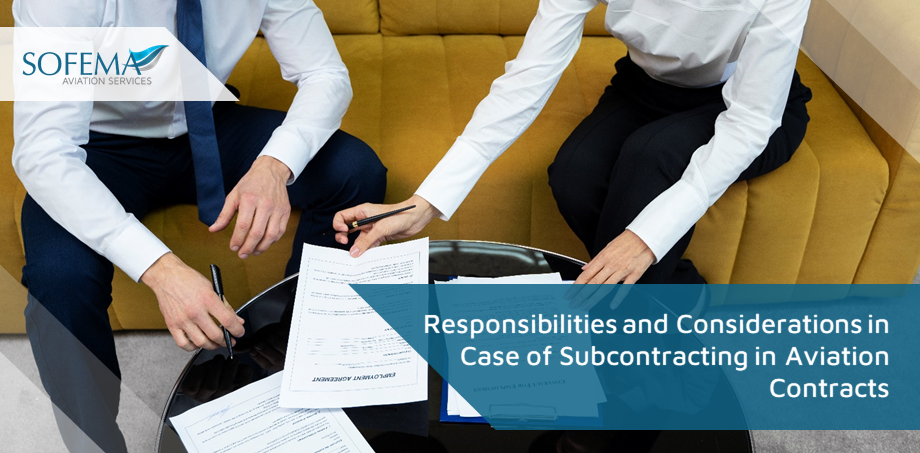Sofema Aviation Services (SAS) considers key elements to be included within Aviation Contracts when subcontracting activities.
Introduction – Challenges in Subcontracting Services and Activities
Subcontracting services and activities plays a critical role in ensuring operational efficiency and meeting specialized needs. However, it also introduces significant challenges, particularly when complying with stringent regulatory frameworks such as EASA or FAA.
The ultimate responsibility for regulatory compliance and safety lies with the primary contractor—whether an airline, maintenance organization, or CAMO—which cannot be transferred to subcontractors.
- Any failure to meet these standards can result in severe penalties, operational disruptions, and safety risks, highlighting the need for robust oversight and governance structures.
One of the major challenges lies in maintaining consistent quality and adherence to safety requirements, especially when managing multiple subcontractors across various tasks. Subcontractors often lack a comprehensive understanding of specific aviation safety protocols, operational expectations, or technical intricacies.
Under EASA regulations, subcontractors are typically not permitted to issue certifications, making it essential for the primary contractor to retain full oversight of the subcontracted activities. This can become resource-intensive, particularly when subcontractors require additional training, tools, or support to meet quality benchmarks.
Consider the following:
- Subcontracted work must comply with EASA/FAA regulations, and ultimate responsibility for compliance rests with the primary contractor (e.g., an airline or maintenance organization).
- Failure to ensure regulatory adherence can result in penalties, safety risks, or operational disruptions.
- Maintaining consistent quality of services performed by subcontractors is challenging, particularly when managing multiple entities.
- Subcontractors may lack full understanding of specific aviation safety and operational requirements.
- The primary contractor must retain oversight of the subcontractor’s activities, as subcontractors are generally not allowed to issue certifications under EASA regulations.
- In the case of incidents caused by subcontractors, liability can become a contentious issue.
- Proper indemnity and liability clauses must be incorporated to mitigate risks.
- Poor communication between the primary contractor and subcontractor can lead to delays, errors, or misalignment with regulatory requirements.
- Subcontractors may lack adequate training, tools, or resources, requiring additional oversight from the primary contractor.
Best Practices for Subcontracting in Aviation
Effective subcontracting relies on clear, detailed contracts that define the scope of work, deliverables, timelines, and quality benchmarks. These contracts must emphasize that responsibility for certification and compliance, particularly with EASA/FAA regulations, remains with the primary contractor.
This accountability ensures that safety and regulatory standards are upheld at all times. Clauses mandating compliance with Safety Management Systems (SMS) and regulatory requirements must be incorporated, alongside structured processes for approving any changes to scope, timeline, or deliverables.
To ensure subcontractor performance meets aviation industry standards, regular audits, performance reviews, and monitoring against predefined KPIs are critical. Subcontractors must undergo rigorous assessments before engagement, focusing on their regulatory compliance capabilities and competence.
Training provisions within contracts are essential, enabling subcontractors to align with aviation-specific requirements, while competence assessments ensure ongoing proficiency.
Consider the Following which Summarizes Best Practices
- Contracts must clearly outline the scope of subcontracted work, expected deliverables, timelines, and quality benchmarks.
- Responsibility for certification and compliance must remain explicitly with the primary contractor.
- Regular audits and performance reviews of subcontractors ensure compliance with safety and regulatory standards.
- Subcontractor performance must be monitored against pre-defined KPIs.
- Contracts should include clauses mandating compliance with all applicable EASA/FAA regulations and Safety Management Systems (SMS).
- Subcontractors must be assessed for their ability to meet regulatory standards before engagement.
- Include clear processes for approving changes to the scope, timeline, or deliverables when subcontractors are involved.
- Unanticipated changes should follow structured approval mechanisms.
- The primary contractor should ensure subcontractors receive adequate training to meet aviation standards.
- Competence assessments should be part of subcontractor evaluations.
- Contracts should include provisions for indemnity to protect the primary contractor in case of non-performance or safety failures by subcontractors.
- Limitations of liability must be agreed upon to distribute risk appropriately.
- All records of subcontractor performance, approvals, and audits should be maintained to meet regulatory requirements (e.g., EASA Part M, Part 145).
- Contracts must include strategies for handling subcontractor failures, including alternative solutions to ensure uninterrupted operations.
- Include clauses for scaling subcontractor activities based on project demands while maintaining compliance and quality.
Key Responsibilities Under EASA Regulations
Under EASA regulations, the primary contractor retains ultimate responsibility for ensuring airworthiness, quality, and compliance, regardless of whether work is performed in-house or subcontracted.
This responsibility includes overseeing that all activities meet the regulatory requirements stipulated under relevant EASA Parts. The primary contractor cannot delegate this responsibility to subcontractors, meaning they must maintain complete accountability for the end product or service, ensuring it adheres to the approved quality standards and technical specifications required for airworthiness.
- Retain ultimate responsibility for airworthiness, quality, and compliance.
- Manage and approve subcontractor work through clear oversight mechanisms.
- Ensure subcontracted work aligns with the requirements of the approved scope of work as applicable.
Subcontractor Responsibilities:
Subcontractors must adhere to the scope of work as outlined in their contracts. This includes a clear understanding of the tasks, deliverables, and performance standards expected.
Subcontractors are responsible for managing their resources, schedules, and processes to ensure tasks are completed within the defined timelines and quality benchmarks.
This disciplined adherence minimizes risks of operational delays, safety hazards, or regulatory violations. Subcontractors should communicate any concerns or limitations they foresee in delivering the defined scope. Structured processes for requesting changes, supported by proper justification, allow primary contractors to review and approve adjustments efficiently while maintaining project integrity.
- Follow the scope of work defined in the subcontract.
- Provide necessary documentation and records to the primary contractor.
- Ensure their work aligns with the technical and regulatory standards outlined in the contract.
Next Steps
Follow this link to our Library to find & download related documents for Free.
Sofema Aviation Services and Sofema Online provides classroom, webinar and online training – please see the websites or email team@sassofia.com for comments of questions.
Tags:
KPIs, defined scope, maintaining compliance, regulatory violations, operational expectations, aviation safety protocols, subcontractors, aviation contracts, Operational Disruptions, safety requirements, Aviation Quality, Safety Hazards, Safety Management Systems (SMS), Safety Risks, SAS blogs, EASA regulations, FAA, Part 145, EASA Part M, CAMO





